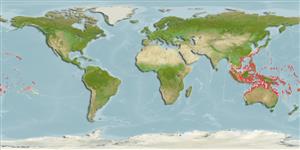>
Eupercaria/misc (Various families in series Eupercaria) >
Labridae (Wrasses) > Corinae
Etymology: Macropharyngodon: Greek, makros = great + Greek, pharyngx = pharynx + Greek,odous = teeth (Ref. 45335).
More on author: Valenciennes.
Environment: milieu / climate zone / depth range / distribution range
Écologie
marin récifal; non migrateur; profondeur 0 - 60 m (Ref. 128797), usually 0 - 30 m (Ref. 27115). Tropical; 24°C - 28°C (Ref. 27115); 30°N - 30°S, 94°E - 124°W
Indo-Pacific: Cocos-Keeling Islands in the eastern Indian Ocean to western Pacific and islands of Oceania.
Taille / Poids / Âge
Maturity: Lm ? range ? - ? cm
Max length : 15.0 cm SL mâle / non sexé; (Ref. 9823)
Épines dorsales (Total): 9; Rayons mous dorsaux (Total): 11; Épines anales 3; Rayons mous anaux: 11; Vertèbres: 25. Color in life of young and females whitish to greenish with irregular black spots; males orange-red with greenish yellow spots (edged in blue and black, per scale); head spotted and banded. Anterior lateral line scales with 2-4 pores. Pelvic fins short, not reaching anus.
Inhabits subtidal reef flats and outer lagoon and seaward reefs (Ref. 1602). Usually in areas with mixed sand, rubble, and coral (Ref. 9710). Feeds mainly on gastropods, other hard-shelled prey (Ref. 9823), and foraminiferans (Ref. 37816). Rarely marketed.
Life cycle and mating behavior
Maturité | Reproduction | Frai | Œufs | Fécondité | Larves
Oviparous, distinct pairing during breeding (Ref. 205).
Randall, J.E., 1978. A revision of the Indo-Pacific labrid fish genus Macropharyngodon, with descriptions of five new species. Bull. Mar. Sci. 28(4):742-770. (Ref. 2694)
Statut dans la liste rouge de l'IUCN (Ref. 130435)
Menace pour l'homme
Harmless
Utilisations par l'homme
Aquarium: Commercial
Plus d'informations
RéférencesAquacultureProfil d'aquacultureSouchesGénétiqueElectrophoresesHéritabilitéPathologiesTraitementNutrientsMass conversion
Outils
Articles particuliers
Télécharger en XML
Sources Internet
Estimates based on models
Preferred temperature (Ref.
123201): 24.7 - 28.9, mean 27.7 °C (based on 770 cells).
Phylogenetic diversity index (Ref.
82804): PD
50 = 0.5002 [Uniqueness, from 0.5 = low to 2.0 = high].
Bayesian length-weight: a=0.00977 (0.00470 - 0.02030), b=3.07 (2.89 - 3.25), in cm total length, based on LWR estimates for this (Sub)family-body shape (Ref.
93245).
Niveau trophique (Ref.
69278): 3.1 ±0.4 se; based on diet studies.
Résilience (Ref.
120179): Haut, temps minimum de doublement de population inférieur à 15 mois (Preliminary K or Fecundity.).
Fishing Vulnerability (Ref.
59153): Low vulnerability (10 of 100).
Nutrients (Ref.
124155): Calcium = 87.4 [51.0, 145.0] mg/100g; Iron = 0.717 [0.422, 1.341] mg/100g; Protein = 18.3 [15.4, 20.5] %; Omega3 = 0.149 [0.095, 0.231] g/100g; Selenium = 23.3 [14.4, 41.4] μg/100g; VitaminA = 147 [46, 547] μg/100g; Zinc = 1.87 [1.30, 3.01] mg/100g (wet weight);
